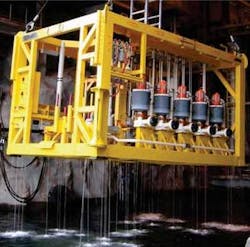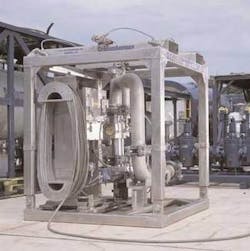Accurately measuring multiphase flow rates in conditions once considered untestable
Subsea or topside, continuous dynamic measurement
null
Jon Arve Svaeren, Framo Engineering; Eric D. Toskey, Schlumberger
A technology using state-of-the-art science to accurately measure the flow rates of oil, gas, and water in pressurized, multiphase flow both for oil and gas wells has been jointly developed by Framo Engineering and Schlumberger. The Vx technology’s multiphase flow rate measurement capability is for mobile well testing or permanent installations.
In the oil and gas industry, which is somewhat conservative in adopting new practices, it can take 20 years or more for a new technology to be accepted as an industry standard. Take, for example, wireline formation testing, which began in its present form with the introduction of the Repeat Formation Tester (RFT) in 1975. Even though its benefits in formation evaluation were widely appreciated, it took about two decades for wireline-conveyed formation testing to become the standard practice. When a new technology is disruptive in nature, meaning that working methods must be modified and new recommended practices and standards need to be defined, then it can be especially challenging for that technology to reach full industry acceptance and achieve a de facto status of industry standard.
Flow measurements
In the field of well testing and production measurement, the single-phase, separation-based flow measurement has been the standard for decades. A separator is used to separate the flow stream into gas, oil, and water streams, and individual single-phase flow meters are used to measure the flow rate of each phase. This long-standing industry practice has come under challenge as accurate flow rate measurements become the requirement across a wider range of applications. Phase separation cannot always be achieved, leading to inaccurate rate measurement when gas is entrained in liquid flow, liquid in gas flow, or oil-water emulsions, which may be inseparable. Unstable flow, slugs, and large flow variations exacerbate the problem. By their nature, separators impose flow control, dampening flow dynamics, which alter or mask the true well performance. The size and weight of separator vessels and their impracticality for subsea applications make them ineffective for many applications. As a consequence, separators are almost never used for continuous well monitoring, which adds further uncertainty to applications such as allocation accounting.
While single-phase flow measurements have met most of the needs for decades, their limitations and evolving demands have forced the industry to consider new possibilities. The result has been the emergence of multiphase flow measurement technology. Multiphase flow measurement is the rate measurement of a pressurized flow stream in which all three phases of gas, oil, and water may be present, which is beyond the range of single-phase meters. The range of multiphase flow conditions varies from gas with little condensate to oil and water with little or no gas bubbles. The multiphase range covers oil-continuous flow, water-continuous flow, gas-continuous or mist flow, annular flow, slug flow, and fluid conditions such as foaming and emulsions. Surface production of oil wells commonly spans a range of conditions. Even gas-well flow conditions will vary as condensate accumulates and forms liquid slugs. Rarely is multiphase flow stable and predictable. The challenge, therefore, in multiphase flow has been to reliably measure flow rates irrespective of the variability of flow conditions.
A multiphase flow meter is considered successful when it is capable of accurate and repeatable flow measurements from different wells over a range of conditions. Perhaps the most demanding application is that of a mobile well testing service when a single meter may be required to operate over the full range of conditions. Application environments like an exploration well test, an oil well clean-up, or a gas well multirate test may encounter a range of operating conditions from low-pressure to high-pressure, high-temperature. A single meter could not successfully measure multiphase flow rates over such a range of conditions.
Vx technology
The Vx technology uses state-of-the-art science to accurately measure the flow rates of oil, gas, and water in pressurized, multiphase flow both for oil and gas wells. Multiphase flow rate measurement capability was developed to handle mobile well testing (PhaseTester Vx) and the multiphase meter for permanent installations (PhaseWatcher Vx).
This flow measurement technology has been evaluated on many occasions by several operators in flow loop and field trials. These include National Engineering Laboratory’s (NEL) joint industry projects (JIP), the Multiphase II JIP for oil applications, and Wet Gas JIP. BP conducted a “shootout” in Deadhorse, Alaska, pitting four different multiphase meters against each other and a test separator, prior to exclusively selecting the PhaseTester Vx for multiphase production well testing.
Framo Engineering and Schlumberger began collaborating in 1998 when the two companies created a joint technology center, 3-PHASE Measurements. 3-PHASE benefits from a mix of expertise and knowledge with deep reach into its parent organizations to engineer, manufacture, and support products and services. This technology was created through extensive international teamwork that resulted in innovations in the core areas of nuclear science, flow modeling, and subsea marinization.
Measurement accuracy enabled the first fiscal allocation of production using a multiphase meter. This application, encouraged by regulatory bodies such as the US Minerals Management Service, the UK Department of Trade and Industry, and the Norwegian Petroleum Directorate, has prompted industry organizations, like the American Petroleum Institute, the International Organization for Standardization, and the Norwegian Society for Oil and Gas Measurement to rewrite production well testing and allocation standards. The meters are also the first multiphase meters to be Web-enabled, allowing operators to access well performance from any place at any time.
New well testing methods
The operational and measurement benefits of this technology also enabled the development of new well testing methods previously not possible. This has lead to the creation of new well testing performance standards. For example, the dynamic response of the measurement allows the clean-up flow from a well, notoriously variable and unstable, to be quantified from start to finish. The information that can be extracted from the clean-up flow data helps optimize rig operations and allows well or completion performance to be quantitatively evaluated. These operational improvements have translated into significant cost savings in field development programs.
This technology is making its mark on the optimization of production, where the benefits of portability and instantaneous measurement have helped create several new well optimizations. In one example, an operator used the meter to audit its production testing facilities and identify ESP optimization candidates. On other examples, coiled tubing nitrogen lift is uniquely optimized for maximum well productivity, and simultaneous surface multiphase flow and downhole production logging measurements are combined for complete well diagnoses.
Marginal and unmanned fields
The increasing use of multiphase metering for subsea tiebacks and offshore production hubs serves as a good example where value is realized. Marginal fields, once deemed uneconomical to produce through conventional facilities, can now be economically produced through a multiphase flow line. Tied to a nearby existing facility, the multiphase flow meter installed subsea or topside is used to monitor production transfer. Compared to conventional measurements, the meter provides a continuous, dynamic measurement, enhancing allocation measurements while reducing shutdowns. Its small size reduces deck load, saving valuable space on a fixed structure.
Unmanned minimum-facilities platforms also make use of multiphase flow measurements. Production from each platform is commingled into a single production flow line where a low-intervention, small-footprint solution and accurate measurements on each flow stream are required.
In an unmanned field offshore Australia, this technology minimized the cost of the infrastructure while still providing a direct testing of each well. The meters are used to facilitate artificial lift and overall well optimization. The meter accuracy proved to be the best method for hydrocarbon allocation, and the meters now form an integral part of the optimization of production from the total gathering system.
In another example in West Africa, Framo installed several subsea multiphase pumping manifolds that were retrofitted to enhance production from existing multiwell subsea manifolds. The wells were produced to the floating production unit with limited possibility to perform individual well testing. By fitting the pump systems with multiphase meters on the same manifold, individual wells can be tested at exactly the same pressure as normal flowing conditions. In addition to pump optimization, the subsea meters play an important role in well optimization. With the combination of a waterflood scheme and additional drawdown provided by the multiphase pumps, the meter delivered value in this high-investment, deepwater field.


